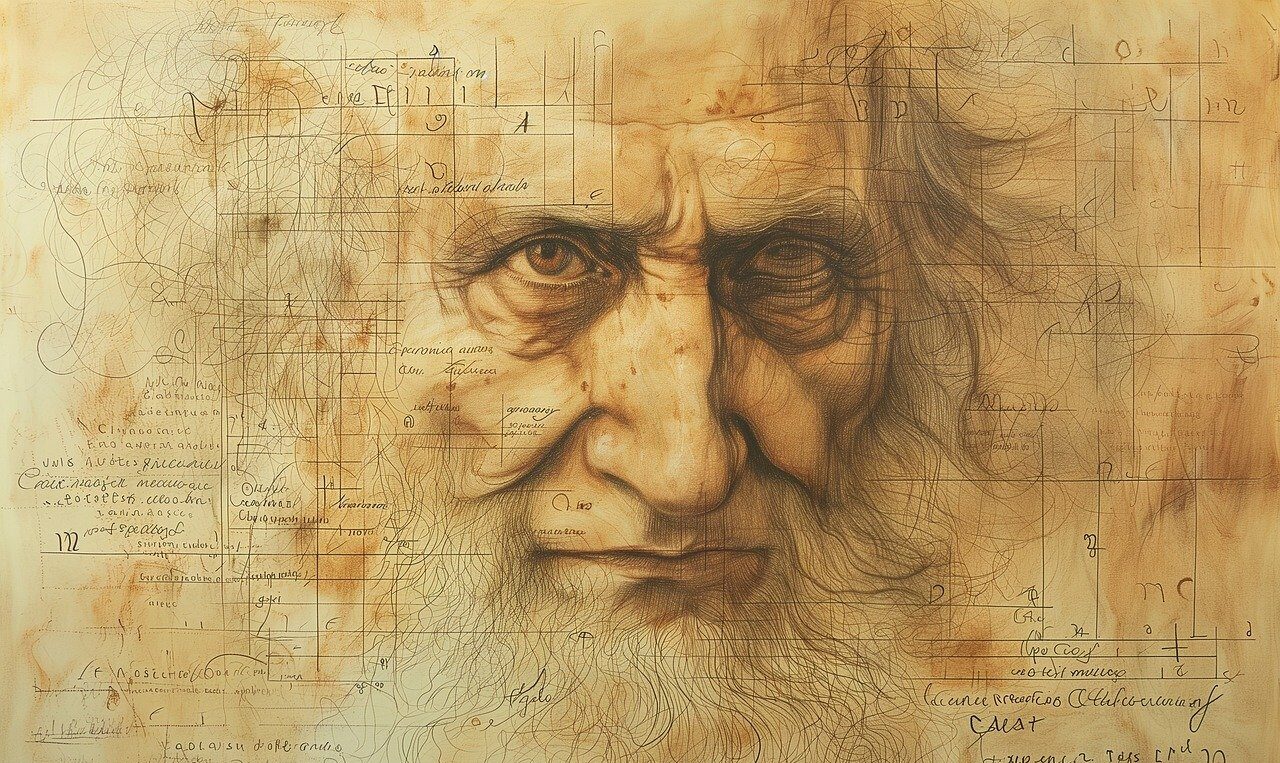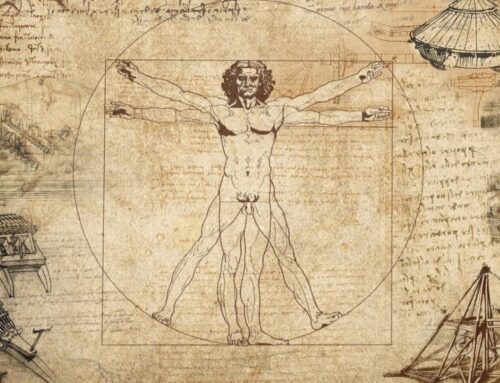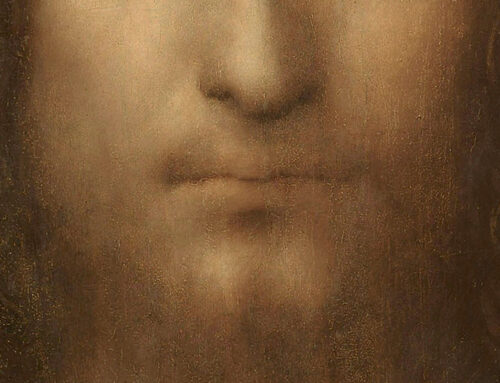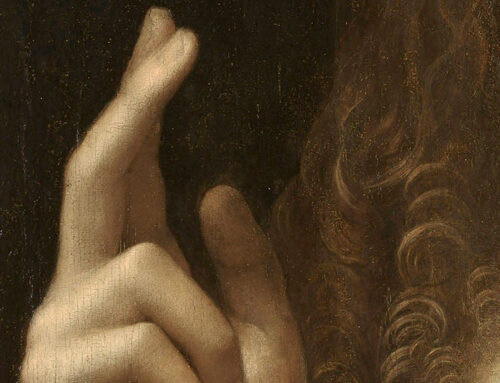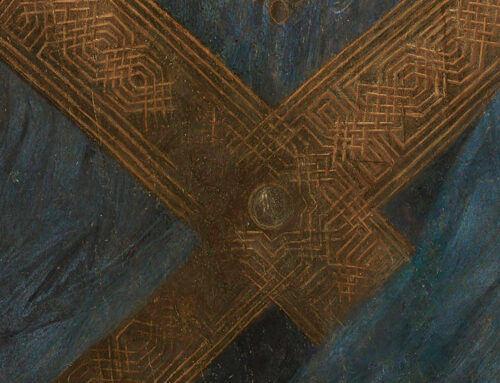While the physical journey of “Salvator Mundi” from the hands of Leonardo to the present day is a tale of loss, rediscovery, and controversy, its spiritual and symbolic journey is equally compelling.
Through its esoteric symbolism, the painting invites viewers to look beyond the surface, pondering the mysteries of the cosmos, the integration of dualities, and the pursuit of knowledge that transcends the material.
In “Salvator Mundi,” Leonardo da Vinci offers not just a portrayal of Christ but an invitation to explore the deeper, universal truths that bind the world together.
The Dual Nature of Christ
Christ’s dual gesture of blessing with one hand and holding the orb in the other could be interpreted through the alchemical maxim of “solve et coagula,” meaning to dissolve and coagulate.
This principle refers to the process of breaking down elements and recombining them into a new, purified form. Christ’s gestures, then, could symbolize the alchemical process of spiritual transformation and rebirth.
Alchemy as a Spiritual Practice
Beyond the physical transmutation of substances, alchemy is also interpreted as a spiritual practice aimed at the transformation of the self. “Salvator Mundi,” in this context, could be seen as a representation of the alchemical journey towards spiritual perfection and unity with the divine, embodied by the figure of Christ as both savior and enlightened master.
Astrological and Cosmological Connections
The discussion of astrological and cosmological connections in Leonardo da Vinci’s “Salvator Mundi” invites a fascinating exploration into how celestial themes might be woven into this enigmatic masterpiece.
While direct evidence of Leonardo’s intentions is scarce, scholars and enthusiasts have speculated on the presence of these connections, drawing on the artist’s known interests in astronomy, geometry, and the natural world.
Whether or not these elements were intentionally embedded in the painting, they invite us to consider “Salvator Mundi” not just as a religious icon, but as a reflection of the Renaissance’s broader quest to harmonize earthly existence with the cosmos’s vast, intricate order.
Here are some of the main theories and interpretations surrounding these aspects:
Celestial Symbolism and the Orb
The transparent orb that Christ holds is a focal point for theories about astrological and cosmological symbolism. Some interpret the orb not just as a representation of Earth but as a symbol of the cosmos at large. Its clarity and lack of distortion could suggest a perfect, divine universe, with Christ’s dominion extending over all creation, seen and unseen.
Leonardo’s Astronomical Interests
Leonardo’s notebooks reveal a deep fascination with the heavens. He meticulously recorded lunar phases, planetary movements, and the stars. This interest in accurately depicting celestial phenomena has led some to suggest that “Salvator Mundi” might include subtle nods to specific astrological configurations or celestial events known during Leonardo’s time.
Integration with Renaissance Cosmology
The Renaissance era saw a revival of interest in the ancient Greek concept of the “music of the spheres,” where the celestial bodies’ movements were believed to produce a harmonic resonance. This concept, linking music, mathematics, and cosmology, might be subtly echoed in “Salvator Mundi” through its harmonious composition and the symbolic depiction of Christ as a cosmic ruler.
Esoteric and Hermetic Wisdom
The period’s intellectual milieu was steeped in Hermeticism, an esoteric tradition that included astrology and alchemy as means to understand the divine order. Leonardo’s incorporation of cosmological and astrological elements into “Salvator Mundi” could reflect these wider cultural currents, suggesting a layered artwork imbued with hidden knowledge and universal truths.
Astrological Motifs
While not overtly depicted, some have speculated that the arrangement of figures, objects, and even the drapery in “Salvator Mundi” could subtly reference zodiacal symbols or planetary alignments, encoding a deeper astrological message about divine influence and human fate.
The Masculine and Feminine
The intertwining of masculine and feminine elements within Leonardo da Vinci’s “Salvator Mundi” can be explored from various perspectives, drawing upon Renaissance artistic norms, esoteric traditions, and modern interpretations.
These dual aspects are not overtly delineated but rather subtly infused through the painting’s composition, symbolism, and the broader context of Leonardo’s oeuvre and interests.
The theories surrounding the masculine and feminine in “Salvator Mundi” offer a rich terrain for exploration, suggesting that Leonardo’s masterpiece, like much of his work, is a profound meditation on the nature of existence, embodying a quest for unity and balance in the human and the divine.
Through this lens, “Salvator Mundi” transcends its religious subject matter, inviting viewers to ponder broader philosophical and metaphysical questions about balance, harmony, and the nature of perfection.
Renaissance Ideals and Androgyny
The Renaissance period, marked by a resurgence of interest in Platonic and Neoplatonic ideas, often celebrated androgyny as a symbol of perfect balance and harmony.
In this context, the depiction of Christ in “Salvator Mundi” might be seen as embodying both masculine and feminine qualities, reflecting a divine perfection beyond mere human dichotomies.
Symbolic Representation
The orb, traditionally a symbol of power and dominion (masculine attributes), is rendered with a delicate, almost ethereal touch, which could be interpreted as embodying feminine principles of nurturing and inclusivity.
Similarly, the blessing gesture, while authoritative, is executed with a grace that softens the traditionally masculine posture of benediction.
Esoteric Interpretations
In many esoteric traditions, the balance between masculine and feminine energies is crucial for spiritual harmony and enlightenment.
The painting’s subtle blend of strength and gentleness, clarity and mystery, may be viewed through this lens as a visual representation of the alchemical marriage, symbolizing the unification of opposites.
Leonardo’s Interest in Universal Harmonies
Leonardo’s extensive studies on nature, anatomy, and physics often touched upon the theme of dualities—light and shadow, solid and void, movement and stillness.
His artistic representation of such dualities might extend to the exploration of gender principles, suggesting a cosmological balance that transcends physical forms.
Contemporary Interpretations
Contemporary discussions around “Salvator Mundi” sometimes delve into gender theory, considering how the painting reflects or challenges historical perceptions of gender.
The nuanced portrayal of Christ could be seen as challenging rigid gender norms, offering a more fluid representation that resonates with current dialogues around gender identity and expression.

